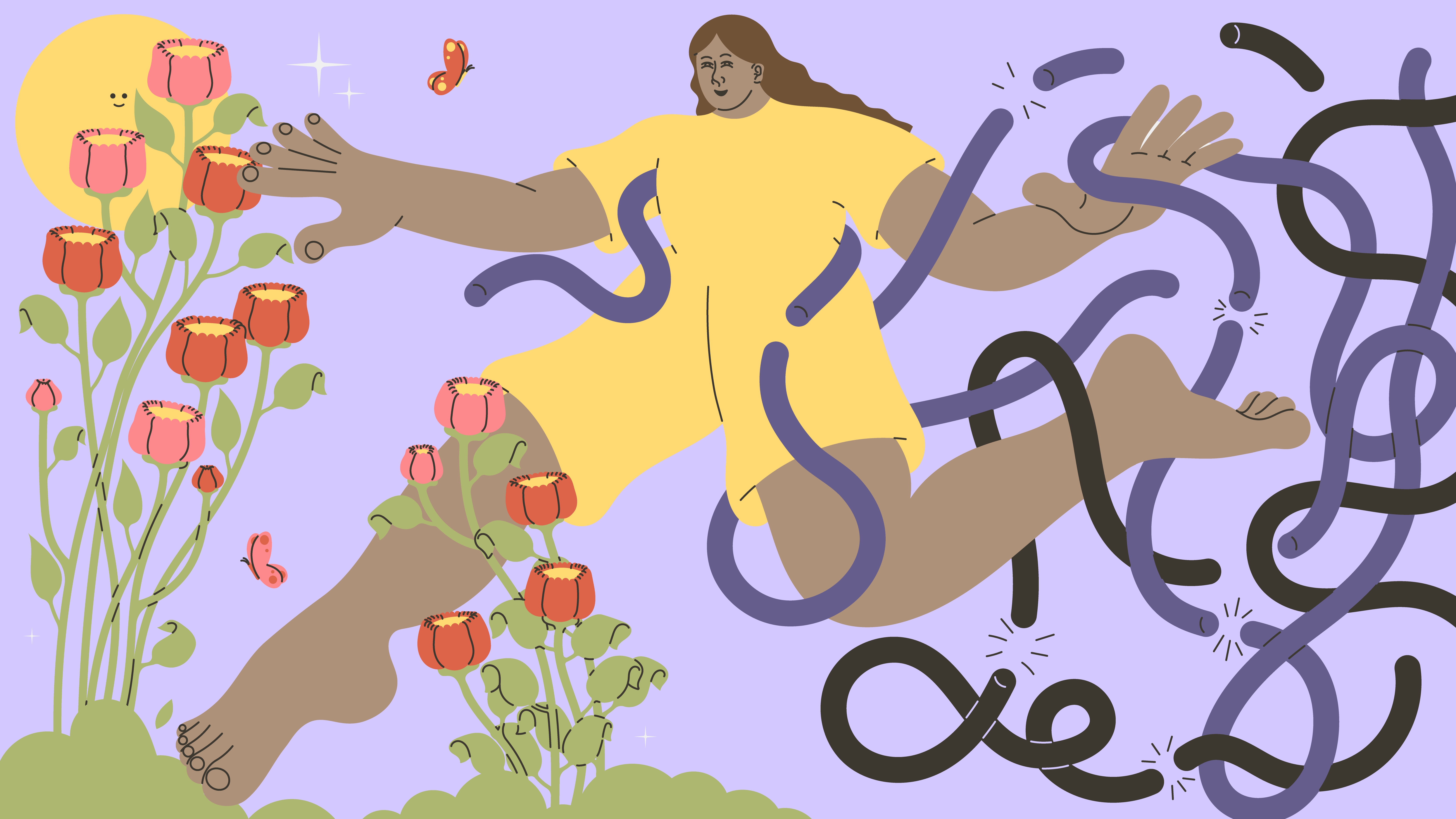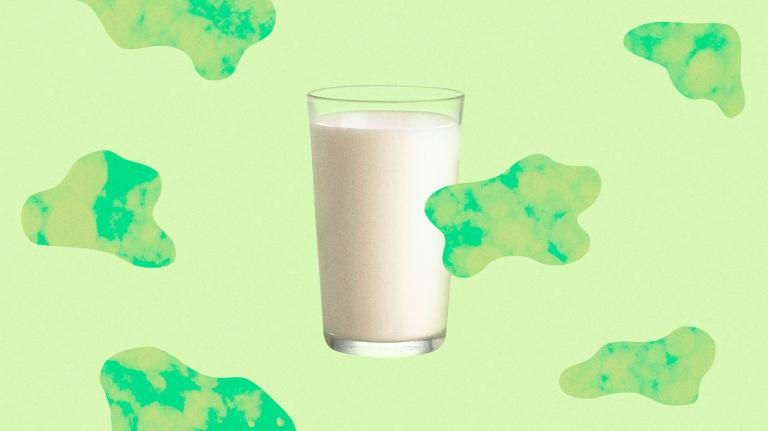Joy can strengthen our resolve, help us unlock creativity, and bolster our resilience. In Fix’s Joy Issue, we explore the importance and power of finding joy in the face of grief, anger, and a changing climate.
On one of those beautiful, cloudless days the Bahamas are famous for, photographer Doc White and his wife, Ceci, dove into the Atlantic Ocean with an assignment to photograph marine mammals. What they considered a routine expedition soon turned into a moment they’ll cherish forever.
As they swam in the crystalline sea, they noticed a pod of spotted dolphins. Awestruck, they longed for a closer look but respectfully kept their distance. Then, something magical happened: The dolphins approached. They made a calm retreat, only to come swimming back moments later. This went on for almost an hour. “I’ve spent a lot of time in the water, and I had never seen that before,” says White.
The pair yearned for that dreamlike moment of physical connection, but resolved to hold out their hands and let the animals decide what to do. “Sure enough, they came up and started nestling against us!” White says, still excited by the memory years later. “Each dolphin acted a bit differently. Some would come very close and touch us; others, while obviously curious, would still keep their distance.”
White had always considered himself an ardent environmentalist and devoted advocate for marine life, but that delightful experience deepened his commitment to protect the natural world. He thinks that if those creatures can exhibit curiosity, playfulness, and joy, they must have other feelings as well — perhaps even an awareness of how the world they share with us is changing.
While we must be careful in viewing animal behavior through the lens of human experiences and anthropomorphic terms, scientists have used simple observations and rigorous testing to assess dolphin behavior. More often than not, their results show that the charismatic creatures exhibit what we’d recognize as joy.
Witnessing that has had a profound impact on White and others. Their close encounters with marine mammals have led them to believe that any solution to the climate crisis must include rethinking our relationship to the natural world. A long history of exploitation and extraction has given many people the idea that we live in a world apart from nature. But if dolphins can, like us, feel joy and other emotions, perhaps we are more connected to them than we realize. And if that is true, perhaps the experiences and perspectives of the animals with which we share this planet should inspire and inform our climate work.
“If you fall in love with a place or an animal and what it gives you,” says White, “then you owe it to that animal to share it with others.”
The secret lives of dolphins
A compelling body of research suggests that dolphins and other animals — dogs, chimpanzees, and elephants being perhaps the most mesmerizing examples — feel a range of sentiments long considered unique to humans, including joy, sadness, empathy, and compassion.
Of course, it doesn’t take a PhD in biology to know dogs are capable of unbridled happiness — anyone who’s watched one catch a Frisbee can see that. Discerning emotions in cetaceans is a harder task, one Janet Mann, a biologist and psychologist at Georgetown University, relishes. Mann has long been fascinated by animal behavior and human interaction. She began her career studying primates but, intrigued by their complexity, shifted her focus to dolphins. “With dolphins, there’s a challenge of wondering what is going on in their heads because they don’t have facial expressions,” she says. “We have important dissimilarities, as well as important similarities.”
If dolphins can exhibit curiosity, playfulness, and joy, they must have other feelings as well — perhaps even an awareness of how the world they share with us is changing.
One of those similarities is remarkable intelligence. Dolphins recognize themselves when looking in a mirror. They can use echolocation to identify an object, then choose a matching object from an assortment of items. They possess sophisticated language skills, understand sentence syntax, and recognize the difference between direct and indirect objects. After homo sapiens, dolphins have the largest brains in relation to their body size. “Their brains developed to that size around 30 million years ago, and our brains only started getting bigger around 1.8 million years ago,” Mann says.
And like humans, dolphins are individual beings with distinct personalities. “When people say, ‘What are dolphins like?’ I’m like, ‘Well, what are humans like?’ It’s tough to give a general answer,” Mann says.” If you look at a crowd, you may observe a general behavior. But if you look at one specific person, you see something entirely different. That’s how we’ve come to study dolphins: as individuals.”
While it’s true many animals express what could be considered joy, dolphins and other cetaceans are perhaps the most relatable example because they are just so much, well, fun. Hard indeed is the heart that can’t see joy in their leaping from the water and crashing with a splash. These friendly creatures have been known to glide through the water among surfers, race alongside boats, and chirp or leap beside canoes.
Elizabeth Henderson, a marine bioacoustic specialist at the Naval Information Warfare Center in San Diego, has seen the animals show compassion and even love. “Sometimes nursing females will adopt calves who have lost their mothers,” she says. “Females will babysit calves at the surface while their mothers forage. In matrilineal societies, such as killer whales, prey is often shared among a pod.” Few who recall the story of Tahlequah, the orca who carried her stillborn calf for 17 days as she swam 1,000 miles through Puget Sound in 2018, doubt she was expressing something akin to grief.
Observations supporting the idea that animals possess rich inner lives have helped spark an idea among a growing number of scientists: Instead of analyzing problems based on how we as humans see them, perhaps we ought to view them from another angle. Opening the lens to consider the perspectives of creatures that rely primarily on sound, or smell, or texture to make their way in the world may lead to new solutions to our most vexing problems, says Kelly Jaakkola, director of research at the Dolphin Research Center in Grassy Key, Florida. The question, she says, isn’t, “How smart are animals?” but rather, “How are animals smart” — and what can they teach us?
[Read more: The science connecting small sustainable actions with greater happiness]
Dolphins are grappling with the myriad effects of their habitats getting warmer and more acidic, and they are showing signs of stress. The animals have been recognized as a sentinel species whose health and well-being provides key data for monitoring oceanic health. Fossil records have long shown evolutionary resilience and adaptation to environmental shifts brought by ice ages and other epochal events. But given the speed with which the climate is changing, such adaptations may no longer be possible.
‘We cannot just take, take, take’
Beyond the realms of biology and behavior, these marine species have long captured the hearts and minds of human observers. The ancient Greeks regularly depicted dolphins in their art, music, and stories. They believed the creatures danced to the natural rhythm of the earth, referring to them as philomousoi, which means “music lovers.” Bacchylides often wove tales of dolphins into his work, with humans leaping into the sea and resurfacing joyously riding dolphins.
Poet, climate activist, and 2021 Grist 50 honoree Craig Perez, who was born and raised in Guam, frequently intertwines his experiences with the cetaceans into his work, which includes a poem about Tahlequah’s loss. He believes that the sense of connection he feels to them and the creativity it sparks is vital to becoming a better, more conscious activist and, in turn, creating a better world.
“In many Pacific cultures, animals are seen as kin, gods, spirit guides, emblems, and nourishment, so they are treated with respect and reverence,” Perez says. “I have been lucky to swim and bond with many marine mammals. More recently, my writing has turned to issues of environmental justice and climate activism, because I became more conscious of how much our ecologies have changed for the worse.”
The shifting climate, coupled with the ongoing legacy of colonialism, has placed coastline communities and island nations on the front lines of this global crisis. They grapple with coral bleaching, diminishing fish stocks, and increasingly frequent storms even as they watch a rising sea reclaim the land they call home.
“Growing up on an island gives you a deep sense of connection to the natural world, to species, and to the ocean itself,” says Cliff Kapono, a professional surfer and chemist who lives in Hilo, Hawaii. “It also instills a sense of resource management. You begin to have this concept that we cannot just take, take, take from this place.”
Kapono has never doubted that we are fundamentally linked to nature, that it is as much a part of us as we are of it. His work as a scientist has only reinforced that belief. One of the first studies he participated in while earning his doctorate in chemistry required extracting a molecule from coral tissue. As it turns out, the same substance is found within the human heart and lungs. From the heart of the ocean to the heart beating within each of us, we are, he says, truly connected to the world around us, and to the creatures with which we share it.
Explore more from Fix’s Joy Issue:
- Art imitates life in plays about finding joy and hope in climate disaster
- When children imagine the future, a world of climate possibilities emerges
- With their beloved sports at risk, outdoor athletes are taking climate action




